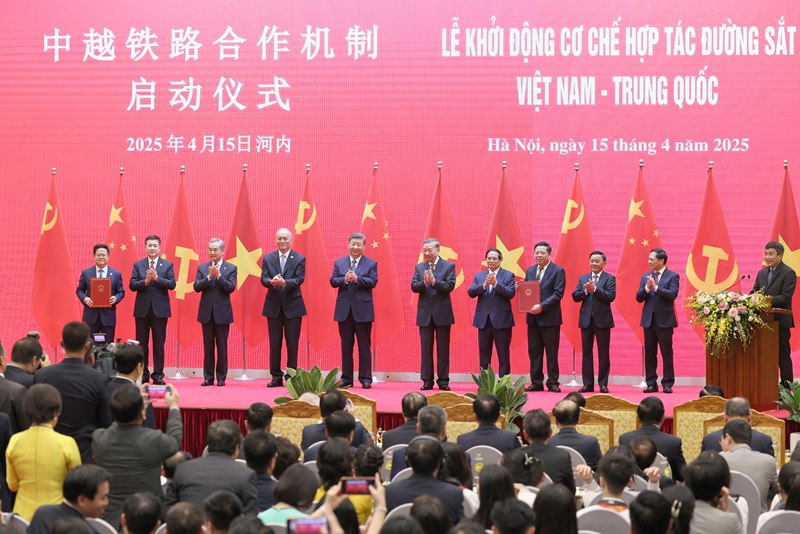




- BRNN
- BRI News
- BRNN News
- Database
Official Documents Polices and Regulations
Inter-government Documents International Cooperation BRI Countries
Business Guide Economic Data BRI Data
Trade
Investment Projects Latest projects
Cases - Content Pool

President Xi Jinping (fifth from left), who is also general secretary of the Communist Party of China Central Committee, To Lam (sixth from left), general secretary of the Communist Party of Vietnam Central Committee, and other Chinese and Vietnamese officials attend the launching ceremony for the China-Vietnam railway cooperation mechanism in Hanoi on April 15, 2025.
Xi Jinping, general secretary of the Communist Party of China Central Committee and Chinese president, and To Lam, general secretary of the Communist Party of Vietnam Central Committee, attended the launch ceremony of the China-Vietnam railway cooperation mechanism in Hanoi on April 15, 2025.
The new mechanism is expected to help Vietnam align its railway gauge with China's widely adopted gauge, creating new opportunities for economic connectivity and development.
Currently, some Vietnamese railways use a 1,000-millimeter gauge, which is incompatible with China's standard 1,435-millimeter gauge. This difference requires repeated transfers for cross-border cargo, limiting logistics efficiency.
Adopting standard-gauge railways is expected to significantly boost Vietnam's cross-border transport capacity, lower logistics costs and allow seamless integration of the two countries’ supply chains. For China, the change would further expand the New International Land-Sea Trade Corridor and add momentum to the China-Indochina Peninsula Economic Corridor.
Improved connectivity is seen as central to jointly advancing the Belt and Road Initiative (BRI). Xi once said, "If the Belt and the Road are likened to the two wings of a soaring Asia, then connectivity is like their arteries and veins."
A single railway can cross rivers and mountains, opening new routes to the future. The wider gauge will also allow for faster speeds and greater capacity, further opening China to the world.
In December 2023, China and Vietnam issued a joint statement to promote the connectivity of cross-border standard-gauge railways. In August 2024, leaders from both countries witnessed the signing of several bilateral agreements, including those on railway cooperation. By December 2024, China and Vietnam announced the signing of an intergovernmental agreement for a cross-border standard-gauge railway project. The planned upgrades to the railway network underscore both nations' commitment to pursuing development together.
During talks with To Lam, Xi said the two countries should expand higher-quality, mutually beneficial cooperation and work to connect their standard-gauge railways as soon as possible. The following day, China and Vietnam launched their railway cooperation mechanism, delivering tangible benefits for both sides.
Beyond the China-Vietnam railway project, other major initiatives are underway in the region, including the China-Thailand Railway and Malaysia’s East Coast Rail Link. The China-Laos Railway and Jakarta-Bandung High-Speed Railway are already providing benefits.
A pan-Asian railway network is gradually taking shape, boosting regional cooperation across Southeast Asia. As new rail links open, improved land and sea connectivity is expected to increase trade and facilitate cross-border exchanges.
Yet, connectivity is about more than just building infrastructure. It is about linking people as well as places.
As Xi said in an important speech at the fourth symposium on Belt and Road construction work in Beijing in December 2024, it is necessary for BRI partner countries to deepen the “hard connectivity” of infrastructure, the “soft connectivity” of rules and standards, and the “heart connectivity” between peoples. He said China would work to strengthen the coordination mechanism for all three areas.
The BRI is not China's solo performance, but a symphony played by all. This is why the BRI has become a bridge of understanding, striking a chord with the world.

Tel:86-10-65363107, 86-10-65368220, 86-10-65363106